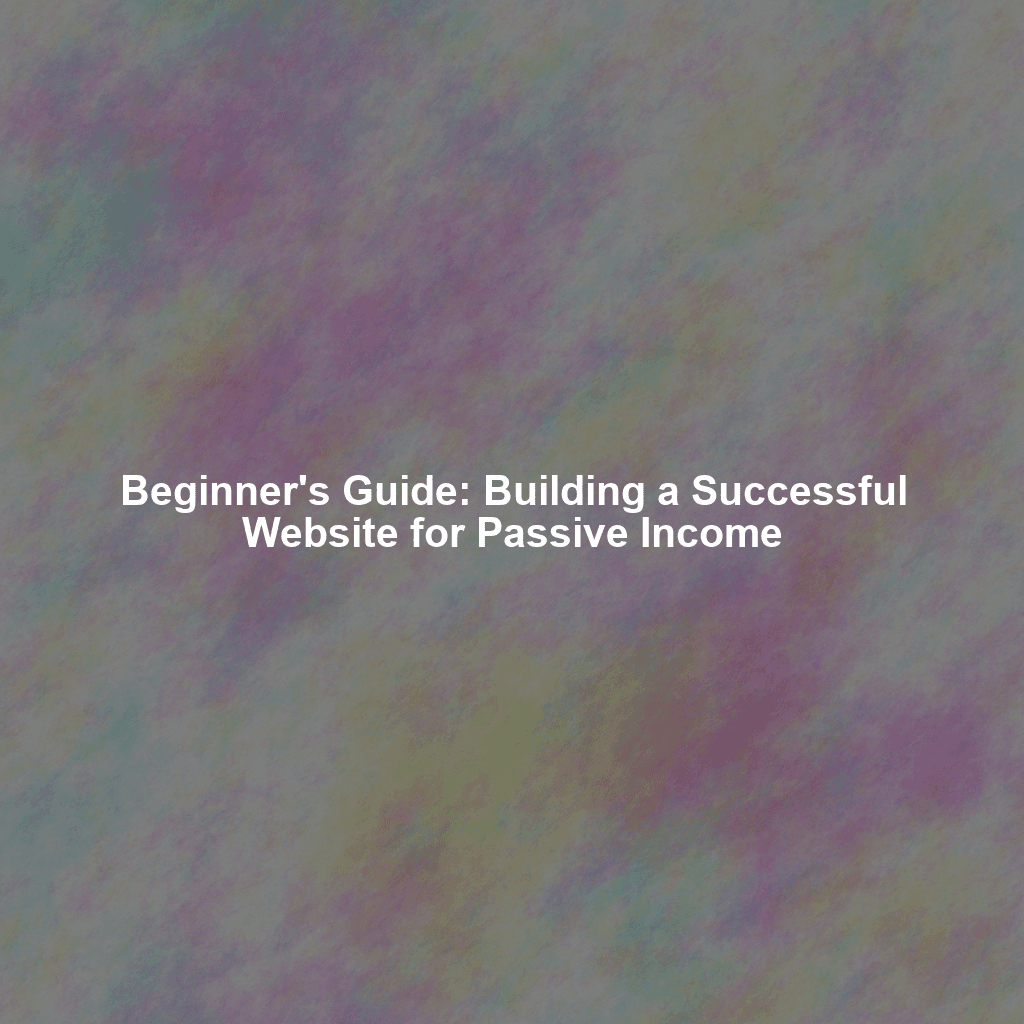Introduction: Your Journey to Passive Income Begins Here
Imagine earning money even while you sleep. It sounds too good to be true, right? Well, it’s not! With affiliate marketing and a well-built website, creating a stream of passive income is absolutely achievable. This guide will walk you through the crucial steps of building a successful affiliate marketing website from the ground up, even if you’re a complete beginner. We’ll bypass the hype and focus on the actionable strategies that actually work.
Affiliate marketing, at its core, is about partnering with businesses to promote their products or services on your website. When a visitor clicks your unique affiliate link and makes a purchase, you earn a commission. The key ingredient for success is having a website that provides value to its visitors, builds trust, and seamlessly integrates your affiliate recommendations.
Step 1: Finding Your Niche – The Foundation of Success
Choosing the right niche is arguably the most important decision you’ll make. A niche is a specific segment of a larger market. Think of it like this: “sports” is a market, while “basketball training for teenagers” is a niche. A more specific niche allows you to target your audience more effectively.
Why is Niche Selection So Important?
- Reduced Competition: Focusing on a niche helps you stand out from the crowd. Competing with established giants in broad markets is incredibly difficult.
- Targeted Audience: A niche allows you to attract a highly specific audience that is actively searching for information and solutions related to your topic.
- Higher Conversion Rates: When you cater to a specific audience with tailored content, your affiliate links are more likely to convert into sales.
- Easier Content Creation: It’s easier to create high-quality, in-depth content when you’re focused on a narrow topic.
How to Choose the Right Niche:
- Passion and Knowledge: Start by considering your interests and expertise. What topics do you enjoy learning about and discussing? Choosing a niche you’re passionate about will make content creation much easier and more enjoyable in the long run.
- Market Research: Validate your niche idea. Are there affiliate programs available in that area? Are people searching for information related to that topic? Use tools like Google Trends, Ahrefs, Semrush, and even Amazon to gauge interest and potential profitability.
- Competition Analysis: Analyze your potential competitors. Are there many established websites in your chosen niche? Don’t be discouraged by competition, but be realistic. Look for areas where you can offer something unique or better than your competitors. Maybe you can specialize in a specific aspect of the niche, or provide more comprehensive and up-to-date information.
- Profitability: Research potential affiliate programs and their commission rates. Some niches are inherently more profitable than others. Consider the average price of products or services in your niche and the commission you can earn per sale.
- Long-Term Potential: Choose a niche that is likely to remain relevant in the long term. Avoid fads and trends that are likely to disappear quickly.
Step 2: Setting Up Your Website – Your Online Home
Once you’ve chosen your niche, it’s time to build your website. Don’t worry, you don’t need to be a coding expert to create a professional-looking website. Thanks to user-friendly platforms like WordPress, the process is much simpler than you might think.
Choosing a Domain Name:
- Relevance: Your domain name should be relevant to your niche and easy to remember.
- Keep it Short: Shorter domain names are easier to type and remember.
- Use Keywords: If possible, include relevant keywords in your domain name. This can help with SEO.
- .com Extension: Stick to the .com extension whenever possible. It’s the most common and recognizable.
Selecting a Web Hosting Provider:
Your web hosting provider is where your website’s files are stored. Choose a reliable provider that offers good uptime, fast loading speeds, and excellent customer support. Some popular options include:
- Bluehost
- SiteGround
- HostGator
- DreamHost
Consider shared hosting for a cost-effective solution when starting out. You can always upgrade to a VPS or dedicated server as your website grows.
Installing WordPress:
WordPress is a content management system (CMS) that makes it easy to create and manage your website. Most web hosting providers offer a one-click WordPress installation.
Choosing a Theme:
A theme controls the look and feel of your website. There are thousands of free and premium WordPress themes available. Choose a theme that is:
- Responsive: Ensures your website looks good on all devices (desktops, tablets, and smartphones).
- SEO-Friendly: Optimized for search engines.
- Fast-Loading: Page speed is a crucial ranking factor.
- Customizable: Allows you to easily customize the design to match your brand.
Some popular and recommended themes include Astra, GeneratePress, and Kadence.
Essential Plugins:
Plugins add functionality to your WordPress website. Here are some essential plugins to install:
- Yoast SEO (or Rank Math): Helps you optimize your website for search engines.
- Akismet Anti-Spam: Protects your website from spam comments.
- Contact Form 7 (or WPForms): Allows visitors to contact you.
- Google Analytics Dashboard for WP: Tracks your website traffic and performance.
- A caching plugin (like WP Rocket or LiteSpeed Cache): Improves website speed.
Step 3: Creating High-Quality Content – The Heart of Your Website
Content is king! To attract visitors and build trust, you need to create high-quality, informative, and engaging content that provides value to your audience.
Types of Content to Create:
- Blog Posts: Share your knowledge, expertise, and opinions on topics related to your niche. Focus on providing solutions to common problems and answering frequently asked questions.
- Product Reviews: Write honest and unbiased reviews of products you’re promoting as an affiliate. Highlight the pros and cons, and be transparent about your affiliate relationship.
- Tutorials and Guides: Create step-by-step tutorials and guides that teach your audience how to do something related to your niche.
- Case Studies: Share real-world examples of how your audience can achieve success using the products or services you’re promoting.
- List Posts (Listicles): “Top 10” lists and other list-based content are highly shareable and engaging.
Content Creation Best Practices:
- Keyword Research: Use keyword research tools to identify the keywords your audience is searching for. Incorporate these keywords naturally into your content.
- Write for Your Audience: Understand your audience’s needs and interests, and tailor your content accordingly.
- Provide Value: Focus on providing valuable information and solutions to your audience’s problems.
- Use Clear and Concise Language: Avoid jargon and technical terms that your audience may not understand.
- Format Your Content for Readability: Use headings, subheadings, bullet points, and images to break up your text and make it easier to read.
- Proofread Carefully: Check your content for grammar and spelling errors before publishing.
Step 4: SEO (Search Engine Optimization) – Getting Found Online
SEO is the process of optimizing your website and content to rank higher in search engine results pages (SERPs). Higher rankings mean more traffic to your website, which translates into more potential affiliate sales.
On-Page SEO:
- Keyword Optimization: Incorporate relevant keywords into your page titles, headings, meta descriptions, and content.
- Internal Linking: Link to other relevant pages on your website. This helps search engines understand the structure of your site and improves user experience.
- External Linking: Link to reputable websites and resources. This shows search engines that your content is well-researched and credible.
- Image Optimization: Use descriptive alt text for your images. This helps search engines understand what your images are about.
- Mobile-Friendliness: Ensure your website is responsive and looks good on all devices.
- Page Speed: Optimize your website for fast loading speeds. Use a caching plugin, optimize your images, and choose a fast web hosting provider.
Off-Page SEO:
- Link Building: Earn backlinks from other reputable websites. This is one of the most important ranking factors.
- Social Media Marketing: Promote your content on social media platforms to drive traffic to your website.
- Guest Blogging: Write guest posts for other websites in your niche to gain exposure and earn backlinks.
Step 5: Promoting Your Website – Driving Traffic and Sales
Creating great content is only half the battle. You also need to actively promote your website to drive traffic and generate affiliate sales.
Effective Promotion Strategies:
- Social Media Marketing: Share your content on relevant social media platforms. Engage with your followers and participate in relevant conversations.
- Email Marketing: Build an email list and send regular newsletters to your subscribers. Share valuable content, promote affiliate products, and build relationships with your audience.
- Paid Advertising: Consider using paid advertising platforms like Google Ads or Facebook Ads to drive targeted traffic to your website. This can be a faster way to generate traffic than organic SEO, but it requires an investment.
- Guest Blogging: Write guest posts for other websites in your niche to reach a wider audience and earn backlinks.
- Forum Participation: Participate in relevant online forums and communities. Share your expertise and link to your website when appropriate.
Step 6: Tracking, Analyzing, and Optimizing – Continuous Improvement
Building a successful affiliate marketing website is an ongoing process. You need to track your performance, analyze your results, and make adjustments to your strategy as needed.
Key Metrics to Track:
- Website Traffic: Track the number of visitors to your website, as well as their source (e.g., organic search, social media, direct traffic).
- Conversion Rates: Track the percentage of visitors who click on your affiliate links and make a purchase.
- Earnings Per Click (EPC): Calculate your average earnings per click on your affiliate links.
- Return on Investment (ROI): Calculate the return on your investment in your website (e.g., domain name, hosting, advertising).
Tools for Tracking and Analysis:
- Google Analytics: Tracks your website traffic and user behavior.
- Google Search Console: Provides insights into your website’s performance in Google search results.
- Affiliate Network Reports: Provides detailed reports on your affiliate sales and commissions.
Optimization Strategies:
- A/B Testing: Experiment with different headlines, calls to action, and layouts to see what works best.
- Content Updates: Regularly update your content to keep it fresh and relevant.
- Keyword Research: Continuously research new keywords and optimize your content accordingly.
- Link Building: Continue building high-quality backlinks to improve your search engine rankings.
Conclusion: Your Passive Income Journey Awaits
Building a successful affiliate marketing website for passive income takes time, effort, and dedication. However, with the right strategy and a commitment to providing value to your audience, you can create a sustainable stream of income that works for you even when you’re not actively working. Remember to choose your niche wisely, create high-quality content, optimize your website for SEO, promote your website effectively, and continuously track, analyze, and optimize your performance. Now go forth and build something amazing!
 Skip to content
Skip to content

